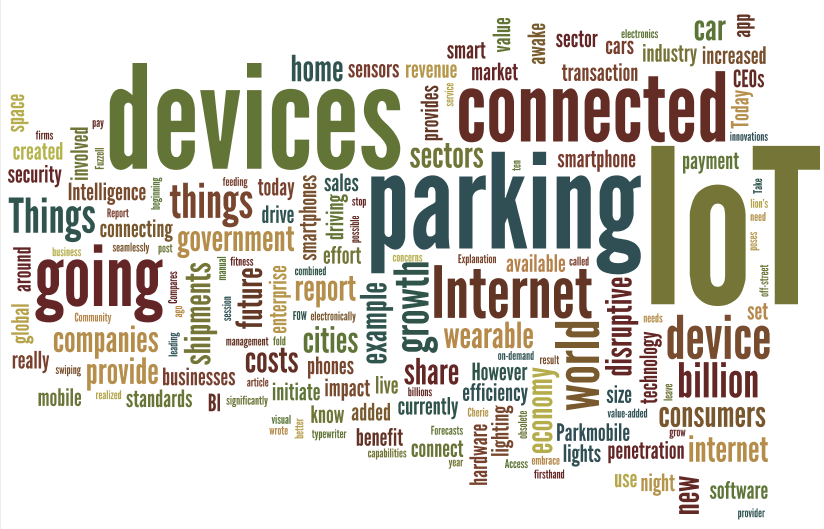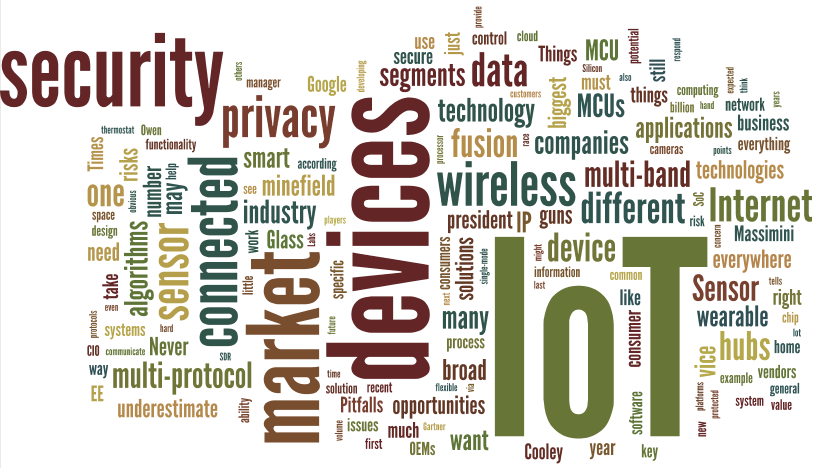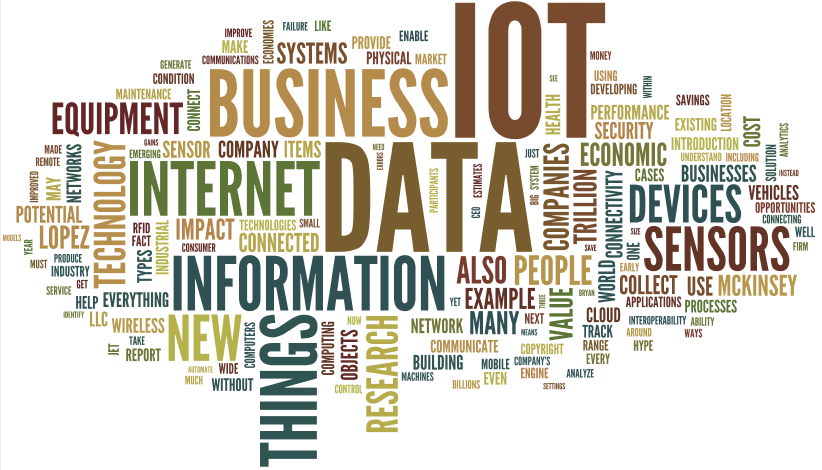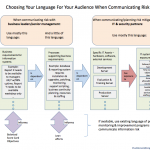
word cloud from 3 business magazine articles on IoT
I was curious if language in articles and blog posts on IoT varied significantly with the type of magazine or blog. So my unscientific quick and dirty research was to use three semi-arbitrarily* chosen articles from three different types of blog or magazine, do word frequency counts in each of these, and then from this do a word cloud where font size varies with frequency of the word count. The three magazine/blog types were: business magazine or blog, industry trade magazine or blog, and vendor magazine or blog. (*I say ‘semi-arbitrarily’ because I chose them all myself and I’m sure my Googling/searching habits aren’t without some bias).
The first word cloud above was made by piling the words of all three articles together and then doing a word frequency count on the combined verbiage, sorting the counts, and then creating a word cloud. I used Wordle.net to do this and it makes the last three steps pretty easy to do.
Similarly, I made sorted word frequency word clouds for articles from three industry/trade magazines/blogs and did the same again for vendor magazines/blogs:

word cloud from 3 industry/trade magazines/blogs

word cloud from 3 vendor blogs
Side by side, they look like:

side by side comparison of the same (click to increase size)
While there are a number of things that could be done to make the comparison more robust (higher sample count, remove ‘stop words‘, etc), I think even this little snippet of samples shares some interesting results (or at least provides direction/motivation for digging deeper with a larger sample set). Some ‘eyeball’ observations from this sample set:
- security & privacy more prevalent in trade/industry articles/posts
- vendor articles/posts seem to hit harder on data
- trades & vendors heavier on sensors
- business sample skewed some with a chunk of text from one article dedicated to talking about IoT parking systems
Language use is important because, among other things, it directly affects how we categorize, classify, and discuss risk.
Again, no smoking gun here and there’s plenty of room to make this more robust, but the use of the language used to talk about IoT it becomes more prevalent might be interesting to keep an eye on.
**********
If you’re interested … the three articles/posts from business magazines/blogs were:
Wall Street Journal –
http://www.wsj.com/articles/the-internet-of-things-will-change-everything-1424664603
Forbes –
http://www.forbes.com/sites/jacobmorgan/2014/10/30/everything-you-need-to-know-about-the-internet-of-things/
Business Insider –
http://www.businessinsider.com/how-the-internet-of-things-market-will-grow-2014-10
The three articles/posts from industry/trade magazines and blogs were:
CIO magazine –
http://www.cio.com/article/2923475/innovation/cios-put-the-internet-of-things-in-perspective.html
Dark Reading –
http://www.darkreading.com/partner-perspectives/intel/securing-the-internet-of-things/a/d-id/1318072
EE Times
http://www.eetimes.com/document.asp?doc_id=1325079
And the three articles/posts from vendor articles/posts were:
Cisco –
http://www.cisco.com/web/solutions/trends/iot/introduction_to_IoT_november.pdf
Microsoft –
http://www.microsoft.com/en-us/server-cloud/internet-of-things.aspx
Atmel –
http://blog.atmel.com/2015/06/26/6-reasons-why-the-iots-true-value-remains-untapped/







